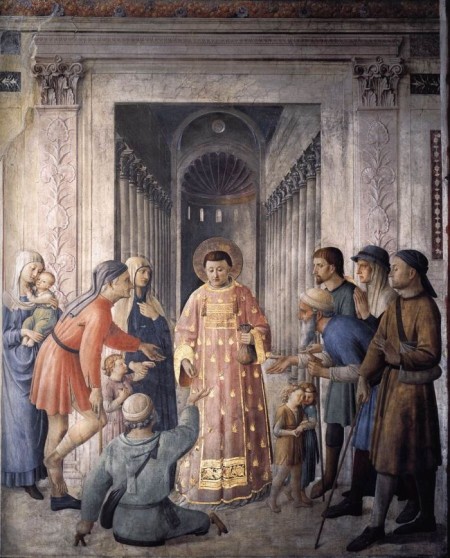 Saint Lawrence Distributing Alms –Image: Pinterest
Saint Lawrence Distributing Alms –Image: Pinterest
(Vatican) Lawrence is believed to have been born in Spain at Osca, a town near Aragon near the foot of the Pyrenees. As a youth, he was sent to Saragonza to complete his secular and theological studies, it was here that Lawrence first encountered the future Pope Sixtus II a teacher in what was then one of the most renowned centers of academic learning–the future Pope was one of the most famous and esteemed teachers.
Lawrence who would become the head of the Deacons of the Roman Church was remarkable for his human qualities, his subtlety of the mind and for his intelligence. Between Master and Disciple a communion of life and friendship grew. With the passage of time, love for Rome, the center of Christianity and seat of the Vicar of Christ, was consolidated and grew stronger in both.
Eventually following a migratory wave which was then very pronounced, both left Spain for the city where the Apostle Peter had established his See and given supreme witness. Thus Master and Disciple were able to realize their ideal of evangelism and missionary activity to the point of shedding their blood in Rome, the heart of Christianity.
Sixtus was raised to the Chair of St. Peter and began a Pontificate which would last for less than a year. — Without hesitation, he desired to have Lawrence his friend and Disciple at his side so as to entrust to him the important Office of Proto-Deacon. Both sealed their life of communion and friendship by dying at the hands of the same persecutor a few days apart from each other.
St. Cyprian, Bishop of Carthage preserves an account of the death of Pope Saint Sixtus in one of his letters. Commenting on the situation of great uncertainty and unease in which the Church found herself because of increasing hostility towards Christians he notes:
“The Emperor Valerian has consigned to the Senate a decree by which he has determined that all Bishops, Priests and Deacons will be immediately be put to death.” Saint Cyprian then continued, “I communicate to you that Sixtus suffered martyrdom on the 6th August together with four Deacons while they were in a cemetery. The Roman authorities have established a norm according to which all Christians who have been denounced must be executed and their goods confiscated by the Imperial treasury.” (CSEL 3, 839-840)
Following Pope Sixtus martyrdom, Lawrence became the principal authority of the Roman Church having been the Church’s treasurer. When he was summoned before the executioners he was Ordered to bring all of the wealth of the Church with him. Lawrence showed up with a handful of crippled, poor and sick men and when questioned replied that, “These are the treasure of the Church.”
Lawrence was immediately then martyred for Jesus Christ by being burned to death this date in 258 on a gridiron.
More here from Franciscan Media and here from EWTN
Tweet